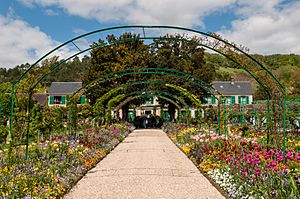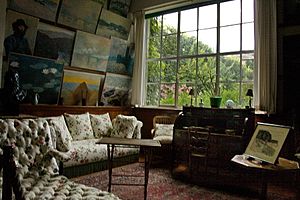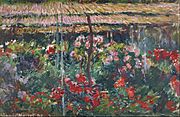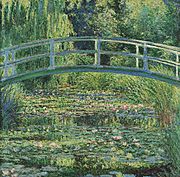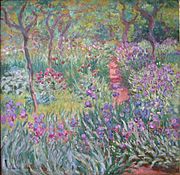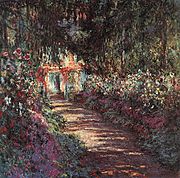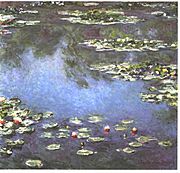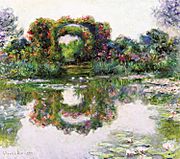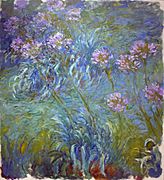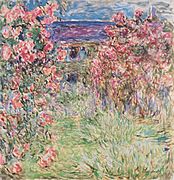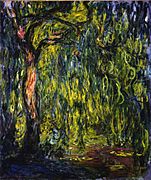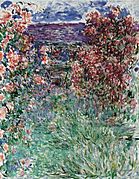Fondation Monet in Giverny facts for kids
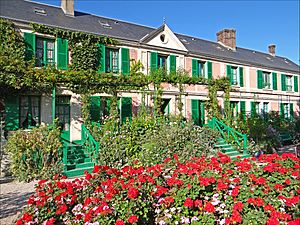
Monet's house from the garden
|
|
| Lua error in Module:Location_map at line 420: attempt to index field 'wikibase' (a nil value). | |
| Established | 1980 |
|---|---|
| Location | Giverny, France |
| Visitors | 750,000 (2023) |
The Fondation Claude Monet is a special place in Giverny, France. It takes care of the house and gardens where the famous artist Claude Monet lived. Monet spent 43 years here, finding lots of ideas for his paintings in his beautiful gardens. He loved nature and believed in painting outside. He created many famous artworks of his home and gardens. Some of his most well-known paintings show the water lilies in his pond, the Japanese bridge, and a weeping willow tree.
This amazing place is very popular! In 2023, about 750,000 people visited. It's one of the most visited spots in Normandy, France. The house and gardens are recognized as important historical sites. They are listed as Maisons des Illustres (Houses of Famous People) and a Jardin Remarquable (Remarkable Garden). The whole property became a protected monument historique in 1976. Many of Monet's paintings of these gardens, especially the water lilies, are shown in art museums all over the world.
| Top - 0-9 A B C D E F G H I J K L M N O P Q R S T U V W X Y Z |
History of Monet's Home
Finding a New Home
In 1883, Claude Monet needed a new place to live. He had a big family, including his five sons and Alice Hoschedé with her six children. He wanted a house big enough for all ten of them! He also wanted to be close to Paris for his art business. But he also wanted to be far enough away from the city's busy art world.
Monet looked for a home in Normandy, a region in France. He traveled by train and discovered a small village called Giverny. It was a quiet place with farms, a blacksmith, and a school. It was also near the town of Vernon, which had schools for his older children.
He found a vacant farmhouse called "Le Pressoir," which means "the cider press." It was a pink house with gray shutters and a slate roof. It had many rooms and a large garden with apple and pear trees. The property was quite big, about 960 square meters (10,333 square feet). It even had a barn and a woodshed.
Monet moved into the house on April 29, 1883, with his two children. Alice and her children joined them the next day. Monet was able to rent the house and start his new life in Giverny.
Creating the Gardens
In their first year, Monet and Alice started planting the garden. They also painted the house shutters green and updated the kitchen. Monet cut down some pine trees to make the garden more open. He also built a boathouse on an island in the nearby Seine River. He loved exploring the area by boat.
By 1885, Monet turned the barn into his art studio. He added a wooden floor and a large window. It's believed that he started painting his garden in 1888. He was very interested in different kinds of flowers. In 1889, he saw special water lilies at an exhibition in Paris. He even met the person who created them, Joseph Bory Latour-Marliac.
Buying the Property
In May 1890, the owner of "Le Pressoir" decided to sell the house. Monet really wanted to buy it! He wrote to his art dealer, Paul Durand-Ruel, asking for money. Monet said he would be very sad to leave Giverny because he loved the area so much. Even though Monet was becoming quite wealthy from his paintings, he still needed help to buy the house.
The sale was completed on November 17, 1890. Monet bought the property for 20,000 francs. The house now officially belonged to him!
In 1891, a Japanese gardener gave Monet advice. This was probably Wasuke Hata, who helped create the Japanese garden at the 1889 World's Fair in Paris. Monet hired his first gardener in 1892. By 1904, he had six full-time gardeners! One gardener even worked from a small boat to clean the lily pond. Monet spent a lot of money on his garden. He even paid to have the public road nearby paved to keep dust off his precious water lilies.
In 1892, Monet built a new greenhouse with a heating system. He was very careful to protect his plants, especially his gloxinias, during cold nights.
The Water Garden
Monet's love for gardening grew even more in 1893. He bought a piece of land across the railway line from his house. This land was a bit marshy and had a small stream running through it. Monet planned to create a water garden there.
He asked for permission to dig a pond and fill it with water from the stream. Some people in Giverny were worried that his flowers would poison the stream. But Monet was determined! He explained that he wanted to grow "aquatic plants... for the pleasure of the eyes and in order to have subjects to paint." On July 27, 1893, he finally got permission.
By October, the water garden was taking shape. A green bridge, which looked Japanese, was built over the pond. This bridge later became known as the famous Japanese bridge.
After his son Jean got married in 1897, Monet built another studio. This new building had a darkroom, a garage, and a storage area for gardeners. Upstairs, there was a large studio with a big window and a glass balcony. This new studio was mainly used to finish paintings and show them to buyers. The old studio became a smoking lounge.
In 1901, Monet bought more land to make his water garden even bigger. An art critic visited and described the garden as a "masterwork of a goldsmith." In 1902, Monet got permission to divert more water, which allowed him to triple the size of the lily pond. He also added a small island and four new bridges. By February 1902, the work was done, and his gardeners planted more water lilies. Giant bamboo was planted in 1906.
In January 1910, a big flood hit the Seine River. Even though Giverny was on a hill, the floodwaters covered the water garden. Monet was very sad, thinking everything was lost. The garden flooded again in March, leaving it covered in mud. In response, Monet reshaped the banks of the lily pond, giving it the beautiful, curved shape it has today. It was now four times its original size!
Just before his 75th birthday, in 1915, Monet built a third studio. This was a very large building, designed to hold his huge "Grand Decorations" series of water lily paintings. He could move these giant paintings around on wheels.
After Monet's Death
Claude Monet passed away on December 5, 1926. His only surviving son, Michel Monet, inherited everything. This included the Giverny property, the paintings, and a large collection of 243 Japanese prints. Michel wasn't interested in living in the family home. He preferred to go on safaris in Africa.
So, Blanche Hoschedé Monet, who was Monet's stepdaughter and daughter-in-law, continued to live in the house. She kept everything just as Monet had left it, with the help of the head gardener. She also started painting again.
After Blanche died in 1947, the garden was left uncared for. Water lily paintings were stacked against walls, windows were broken, and the lily pond was muddy. Termites even damaged the bridge.
In 1966, Michel Monet died in a car accident. Since he had no children, he left the Giverny estate, along with his father's remaining paintings and art collection, to the Académie des Beaux-Arts (Academy of Fine Arts). Police guards were placed at the property to protect it. An inventory was made, and 48 of Claude Monet's paintings were found, along with works by other famous artists like Auguste Renoir and Edgar Degas. These artworks were moved to the Musée Marmottan Monet in Paris.
Bringing Giverny Back to Life
For a while, there wasn't enough money to fully restore Giverny. But in 1977, Gérald Van der Kemp was asked to help save the property. He was known for successfully restoring the Château de Versailles.
Van der Kemp looked for help from private American donors. Many people, including Lila Acheson Wallace and members of the Mellon family, gave money. Walter Annenberg even funded an underpass so visitors could walk safely between the two parts of the garden.
By the time the estate opened to the public, about 95% of the $7 million restoration cost had been covered by these private donations. This was part of a tradition in America where people donate to charities.
A lot of work was needed. The floors and ceilings were rotting, and a staircase had collapsed. Many windows were broken, and three large trees were growing inside the biggest studio! The pond had to be dug out again. In the flower garden, soil was removed to find the original ground level. Then, the same types of flowers that Monet had planted were replanted.
The Fondation Claude Monet was officially created in 1980. The estate became very popular and now welcomes visitors from April to November each year.
Gérald Van der Kemp passed away in 2001. Florence, his wife, became the curator and continued the renovations until her death in 2008. Hugues Gall took over in 2008 and made the site open seven days a week to meet demand. He passed away in May 2024.
In recent years, Monet's studio salon was rebuilt in 2011, based on old photographs. Copies of the original paintings that were once there were put back. In 2013, Monet's bedroom was recreated, and in 2014, Blanche Hoschedé-Monet's bedroom was also opened to the public.
James Priest, a British gardener, has been in charge of restoring Monet's garden. He has studied Monet's painting style to help bring the garden back to its original beauty. He says that even though the garden has changed over time, it is still beautiful and has great potential. He is working to restore the lily ponds and flower beds to Monet's original color designs.
Monet's garden at Giverny is one of France's most visited places. There are long-term plans to make sure it stays beautiful for many years to come.
Exploring the House and Gardens
Inside Monet's House
Visitors can explore several parts of Monet's home:
- Ground Floor: You can see the blue salon (a reading room), the "épicerie" (a pantry), the living room, the dining room, and the blue-tiled kitchen.
- First Floor: This floor has the family bedrooms, including Monet's own room, which was restored in 2013. You can also see Alice Hoschedé's bedroom and their private apartments. Blanche Hoschedé's room was also recreated in 2013 using old records and items found in the house.
- The Studio: Next to the house is the large studio where Monet painted his huge Water Lilies artworks. These paintings are now displayed in the Musée de l'Orangerie in Paris. Today, this studio is the Foundation's gift shop.
The Beautiful Gardens
The garden is split into two main parts, both restored to look just as Monet designed them: the formal Clos Normand and the water garden with its famous water lilies and Japanese bridge.
- The Clos Normand: This part of the garden was Monet's own artistic creation. He spent years turning it into a living outdoor painting. He planted thousands of flowers in neat, straight rows, creating a colorful masterpiece.
- The Water Garden: In 1893, Monet bought land across the road and turned it into a water garden. He diverted water from a small stream to create the pond. This garden became famous during his lifetime because of his amazing series of paintings called Nymphéas. The water garden shows Monet's love for Japan, with its green Japanese bridge and special plants. The famous water lilies were carefully looked after by a gardener whose only job was to care for them.
Monet's Paintings of His Garden
-
Jardin de pivoines, 1887, National Museum of Western Art (Tokyo)
-
Dans le jardin, 1895, Fondation et Collection Emil G. Bührle (Zürich)
-
Le Jardin de l'artiste à Giverny, 1900, Musée d'Orsay, (Paris)
-
Le Jardin de l'artiste à Giverny, 1900, Yale University Art Gallery, (New Haven)
-
La Grande allée à Giverny, 1900, Musée des beaux-arts de Montréal
-
Water Lilies, 1906, Art Institute of Chicago
-
Les Arceaux fleuris, Giverny, 1913, Phoenix Art Museum, Phoenix
-
Iris jaunes, 1914, National Museum of Western Art (Tokyo)
-
Le Chemin à travers les iris, 1914, Metropolitan Museum of Art (New York)
-
Les Agapanthes, 1914, Museum of Modern Art, (New York)
-
La Maison à travers les roses, 1917, Albertina, (Vienna)
-
Weeping Willow, 1918, Columbus Museum of Art
-
Le Chemin de roses à Giverny, 1920, Musée Marmottan (Paris)
-
La Maison entre les roses, 1925, Thyssen-Bornemisza Museum (Madrid)
-
Glycine, 1925, Gemeentemuseum Den Haag (The Hague)
Monet's Japanese Prints
While many of Monet's paintings are in the Musée Marmottan Monet, his house in Giverny has a special collection of 243 Japanese prints. These prints are from the 18th and 19th centuries, and 211 of them are on display. Monet loved Japanese prints from a young age. His passion for them influenced some of the choices he made in his Giverny gardens, especially the water garden.
The collection includes many prints by famous Japanese artists like Kitagawa Utamaro, Katsushika Hokusai, and Utagawa Hiroshige. Some of the most famous prints you can see are Hokusai's The Great Wave off Kanagawa and one of Mount Fuji.
See also
 In Spanish: Fundación Monet en Giverny para niños
In Spanish: Fundación Monet en Giverny para niños
- Musée Marmottan Monet, Paris
- List of single-artist museums


